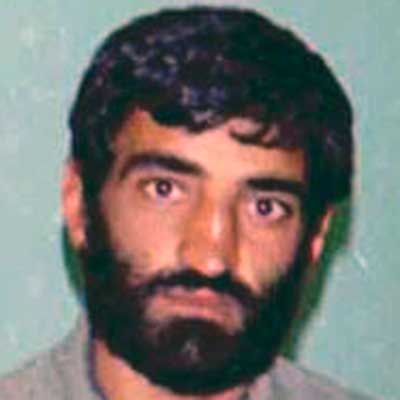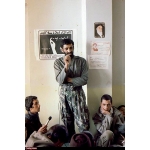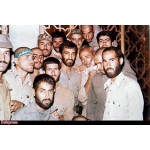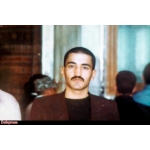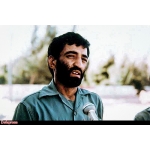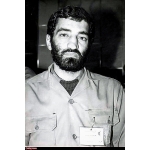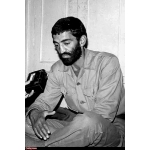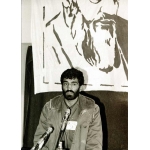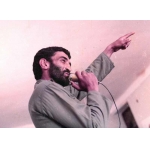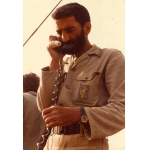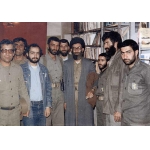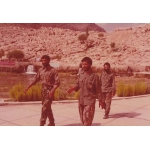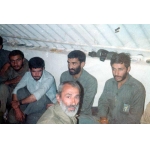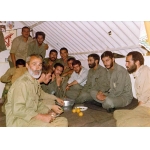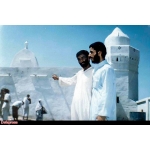Motevaselian, Ahmad
neda Arba'a
1114 بازدید
Ahmad Motevaselian (b. 1953 – ?), was the commander of the 27th Muhammad Rasulullah (pbuh) Brigade during the early years of the Iran-Iraq War. On July 5, 1982, he was abducted by Phalangists affiliated with Israel in southern Lebanon, and no trace of him has been found since.
Ahmad Motevaselian was born on April 4, 1953, in the Seyyed Esmaeil neighborhood of Tehran. In 1973, he attended industrial school and received his diploma. Then, he started working for a private company. Two years later, Motevaselian went to Shiraz for military service, participated in a special tank training course, and was dispatched to Sarpol-e Zahab as a second sergeant in tank command.[1]
In 1971, Motevaselian began secret activities against the Pahlavi regime in Tehran and Lorestan. In 1976, he was admitted into the Tehran University of Science and Technology to study electronic engineering. During the 1977 public demonstrations in Qom and Tabriz, he coordinated the protests in the neighborhoods of southern Tehran. Later that year, he moved to Khorramabad. On September 6, 1978, he was arrested and spent three months in solitary confinement at the Falak al-Aflak Prison in Khorramabad. On November 28, 1978, he was released along with other political prisoners and returned to Tehran.[2]
After the victory of the Islamic Revolution, Motevaselian became active in committees involved in revolutionary activities. With the establishment of the Islamic Revolutionary Guard Corps (IRGC), he took command of the strike unit of the 6th Tehran District. In March 1979, he was dispatched to Turkmen Sahra to counter anti-revolutionary groups. Later, he voluntarily engaged in operations carried out in Kurdistan, including Boukan, Saqqez, Mahabad, Paveh, Marivan, Javanroud, and Ravansar as separatist tensions escalated.
In 1979, as the commander of IRGC units in Boukan, Saqqez, and Mahabad, he played a significant role in clearing these cities of anti-revolutionary elements. On January 3, 1980, under the command of Muhammad Boroujerdi, Motevaselian was tasked with securing the Paveh-Kermanshah Road and breaking the siege of Paveh. By mid-1980, he managed to liberate the city of Marivan and later on was appointed as the IRGC commander of the city.[3]
In 1981, Motevaselian performed hajj with Muhammad Ebrahim Hemmat and Mahmoud Shahbazi. On January 2, 1982, he along with Hemmat led the Operation Muhammad Rasulullah (pbuh) carried out in Marivan and Paveh to secure the international borders in the Oramanat area.[4] Following this operation, on January 4, 1982, Mohsen Rezaei, the then-commander of the IRGC, asked Motavaselian and Hemmat to form a combat brigade. Ten days later, Motevaselian, along with Hemmat and Shahbazi, as well as 120 IRGC forces of Paveh, Hamedan and Marivan went to Khuzestan. Finally, on the 6th of February 1982, the 27th Muhammad Rasulullah (pbuh) Brigade was established.[5]
Fath al-Mobin, which began on March 22, 1982, was the first operation in which the Muhammad Rasulullah (pbuh) Brigade participated in under the command of Motavaselian. It aimed at liberating the western bank of the Karkheh River and the Dezful-Dehloran Road.[6] Its second operation, Beit al-Muqaddas, led to the liberation of Khorramshahr on May 24, 1982.[7]
After the liberation of Khorramshahr, Israel invaded southern Lebanon on June 6, 1982. Viewing this attack as a response to Operation Beit al-Muqaddas, the Islamic Republic of Iran decided to support Lebanon. Therefore, a high-ranking military delegation led by Motevaselian was sent to Syria.[8] The first group arrived in Damascus on June 11 and was stationed at the Zabadani Garrison.[9] On June 24, Motevaselian returned to Tehran to report on the situation.
During a meeting with political and military officials on June 26, Imam Khomeini (ra) stated that Israel's attacks on Syria and Lebanon were a plot to divert Iran's attention from countering Saddam's aggression. Emphasizing that "the path to Quds passes through Karbala", he ordered Iranian forces to return home. Then, Motevaselian returned to Syria to oversee the withdrawal of Iranian troops.[10]
On the morning of July 5, 1982, Seyyed Mohsen Mousavi, the chargé d'affaires for the Iranian embassy, visited the Muhammad Rasulullah (pbuh) Brigade's base at the Zabadani Garrison and informed Ahmad Motevaselian that Phalangist and Israeli forces had surrounded the Iranian embassy in Beirut, asking for the destruction of all classified documents. Motevaselian, along other officials, immediately headed to Beirut.[11]
At noon on the same day, when the vehicle carrying the Iranian diplomats was passing through a checkpoint post on its way to Beirut, it was intercepted by the Phalange Party, and the four passengers were abducted. In addition to Ahmad Motevaselian, there were Taqi Rastgar Moqaddam (head of the training and tactics unit), Seyyed Mohsen Mousavi (chargé d'affaires), and Kazem Akhavan (a journalist for Islamic Republic Press Agency) were in the car. On the same day, the Israeli radio announced that General Ahmad Motevaselian had been captured at the Barbara checkpoint.[12]
To this day, no verified information about their fate has been uncovered.[13]
[1] Rahyaftegan Vasal, Tehran: Markaz-e Farhangi Sepah, 1373, p. 99; Nayeri, Hussain, Qesseh-ye Farmandehan/9: Farmandeh-ye Jadid (The Story of the Commanders/9: The New Commander), Tehran: Soura Mehr, 1381, Pp. 8 and 9.
[2] Nayeri, Hussain, Farmandeh-ye Jadid (The New Commander), p. 10; Babaei, Gol-Ali, Dar Halee Az Ghobar (In a Cloud of Dust), Tehran: Saeqeh, 6th Edition, 1391, Pp. 17-21; Rah-yaftegan Vasal, Pp. 99 and 100.
[3] Rah-yaftegan Vasal, p. 100; Babaei, Gol-Ali, Dar Halee Az Ghobar (In a Cloud of Dust), Pp. 22 and 41; Nayeri, Hussain, Farmandeh-ye Jadid (The New Commander), Pp. 10 and 11.
[4] Babaei, Gol-Ali, Dar Halee Az Ghobar (In a Cloud of Dust), p.78 and 79; Rah-yaftegan Vasal, p. 101; Rashid, Mohsen, Atlas Jang-e Iran va Araq (The Atlas of the Iran-Iraq War), Tehran: Markaz-e Motaleat va Tahqiqate Jang Sepah Pasdaran Enqelab-e Eslami, 2nd Edition, 1389, p. 57.
[5] Babaei, Gol-Ali, Dar Halee Az Ghobar (In a Cloud of Dust), Pp. 79-83; Nayeri, Hussain, Farmandeh-ye Jadid (The New Commander), p. 13.
[6] Rashid, Mohsen, Atlas Jang-e Iran va Araq (The Atlas of the Iran-Iraq War), p. 48; Babaei, Gol-Ali, Dar Halee Az Ghobar (In a Cloud of Dust), Pp. 92 and 97.
[7] Rah-yaftegan Vasal, Pp. 101 and 102.
[8] Ibid, p. 102; Babaei, Gol-Ali, Dar Halee Az Ghobar (In a Cloud of Dust), Pp. 153 and 160; Davoodabadi, Hamid, Kamineh July 82 (Ambush July 82), Tehran: Ghoncheh, 1384, p. 392.
[9] Babaei, Gol-Ali, Dar Halee Az Ghobar (In a Cloud of Dust), Pp. 16 and 166.
[10] Ibid, Pp. 177 and 181.
[11] Davoodabadi, Hamid, Kamineh July 82 (Ambush July 82), p. 393.
[12] Babaei, Gol-Ali, Dar Halee Az Ghobar (In a Cloud of Dust), Pp. 200-202; Rah-yaftegan Vasal, p. 103.
[13] Davoodabadi, Hamid, Kamineh July 82 (Ambush July 82), Pp. 393 and 394.


